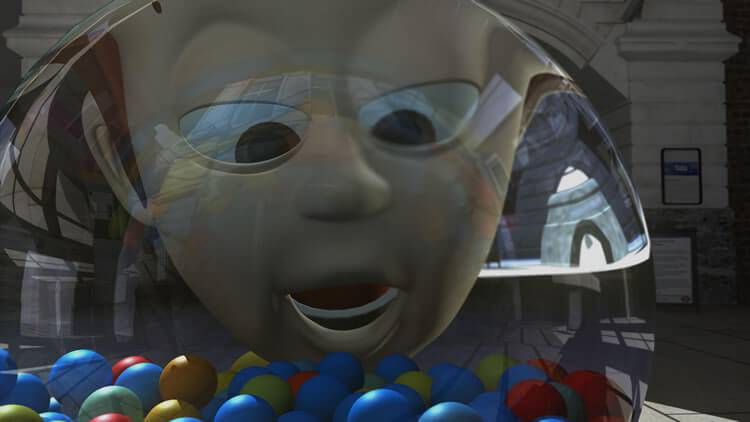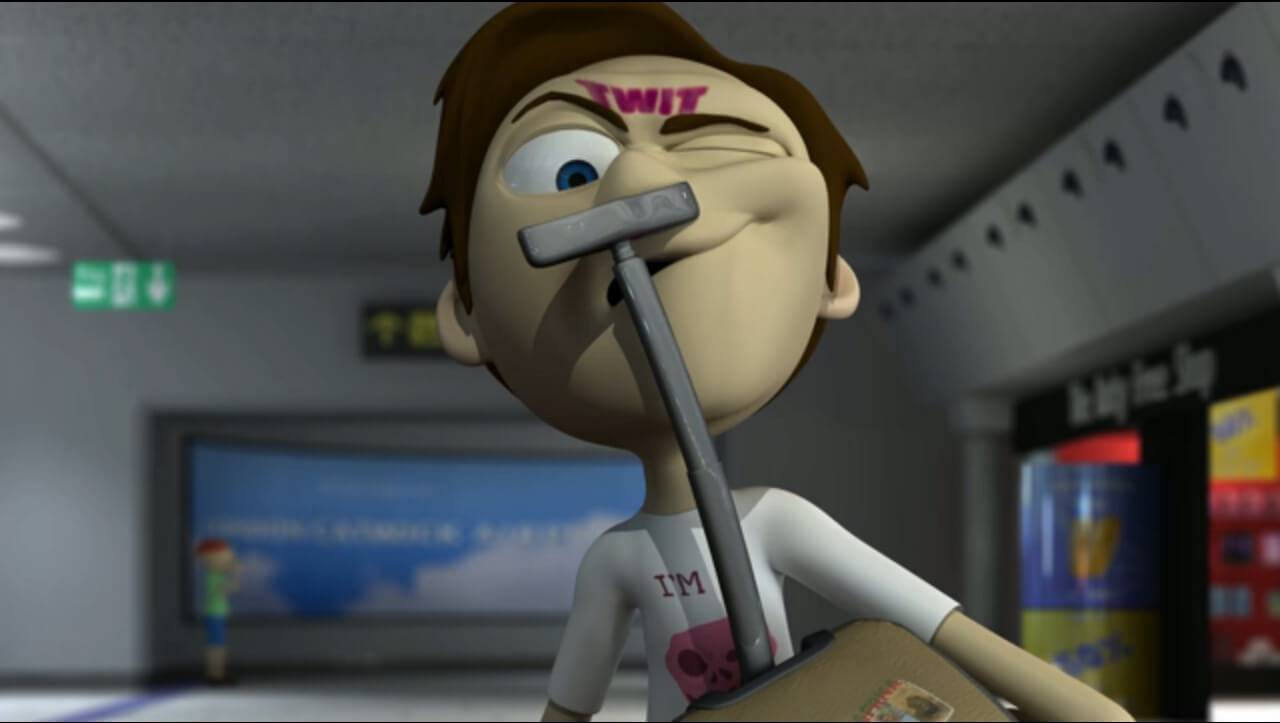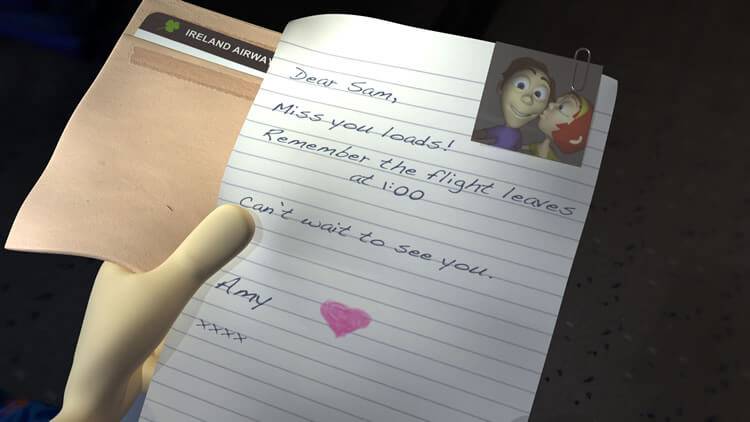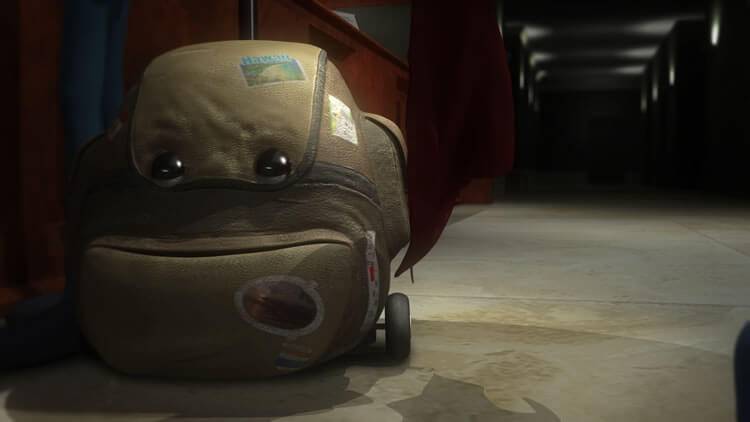Baggage: A Packed Interview With Peter Butler
Baggage is a sweet and funny CGI short about Sam who is late for his flight and doing all he can to get there on time. Unfortunately for Sam, his bag has other ideas. Take a look…
The film was written, directed and animated by Peter Butler who decided to follow his passion for film making after being made redundant having worked for many years in the games industry. The film has already picked up several award and just last week won Best Animation at the Limelight Film Awards in London. I caught up with Peter and asked him to let few trade secrets out of the bag.
Hi Peter, and welcome along to Skwigly. Could you start by explaining where the idea for Baggage came from and how you got started on this project?
The whole idea for Baggage came from watching someone struggling with their pull along suitcase when they were getting off a train. It just occurred to me how much the bag was similar to a parent trying to pull their child away from an arcade or other enticing object. Which is the reason I added a scene in the film with the child and a bowl of sweets.
How long did the film take to you to complete? Did you have a deadline to meet?
It took me about a month to sketch out the ideas for the scenes and design the bag. Although this wasn’t a solid month, it was mainly in my spare time.
Then came the hard work. It took me about two and half months to model and texture all the assets. Then just over a month and half to animate and render.
It was all a bit chaotic as I had a deadline for a film competition that ended on 11th July. I’d started the modelling at the end of February and didn’t start the animation till around mid May.
My original plan was to model/texture then animate and then render. But as the deadline loomed I realised that if I didn’t start rendering in May then I might run out of time. I could always speed up my animation work by cutting out any polish but it was going to be a lot harder to save time on the renders.
So after spending the whole day animating, I’d set up a render to process over night. I’m glad I decided to start rendering earlier as it was a massive learning curve. I’ve done a lot of rendering in the past but we’re talking about many years ago when I used to use a package called Lightwave. I now use Maya to animate and so I had to learn its native renderer Mental Ray.
The first week or so was a nightmare. I was finding I was spending more time setting up a render then I was animating. I’d start setting up a scene for rendering at about 8pm but because of the learning curve I wasn’t getting any good results till around 5am. I was getting up in the morning and spending half the day sorting out the mistakes I’d made in the render the night before, meaning I was then only getting half a day of animation time before I had to continue back on with the next render.
So to finally answer your question, it took me around 5 months in total.
How did you first get started in animation and what drew you to the medium?
I’ve always loved animation since seeing films like Sinbad and the Lost World when I was a child. I was just in awe of how these creatures came alive on screen.
I’d spend many hours creating plasticine stop motion movies with my parents camcorder. Unfortunately the pause button would always record a minimum of 2 secs, so instead of each pose being just a frame,I ended up with every pose being two seconds long. As you can imagine this ended up being a very long and boring animation. I tried to solve this by fast forwarding the tape while recording it to another VHS player. It kind of worked apart from the huge interference line running through the middle.
I didn’t really get into CG animation in till just a few years ago. I’d spent many years in computer graphics, modelling/ texturing and rendering. And although computer animation was an area I really wanted to learn I was always scared off when I looked at things like the graph editor. It just seemed so unintuitive compared to grabbing a piece of plasticine and moving it around. It was only in 2009 when I saw an advert for an online course called Animation Mentor that I decided to really learn the craft.
Baggage is full of excellent character performances. Where did you learn these skills?
Thanks. All of the skills for the characters were things I learnt at Animation Mentor http://www.animationmentor.com/, they really have a good programme in teaching you ways of getting a great performance. One thing I try to do a lot is just observe people. It also helps to carry a sketch pad and when ever you’ve got time, sit down and sketch the people you see. Not detailed sketches, just simple 15 second sketches that really sum up the pose that you noticed them do. To be honest I don’t do this enough but it can help tremendously.
Could you tell us more about the Animation Mentor school of animation, can you explain a little bit about the organisation and how you brought the online community on board to help with the making of this film?
Animation Mentor is an online animation (and now VFX) school. The way it works is that each week you have an assignment. They provide you with all the tools and characters that you’ll need to complete these assignments. You also get a mentor that guides and grades you throughout each term. Using online video lecturing they go through your assignments and give you advice each week. It’s not only a great school but also a brilliant community. Even though it’s online you never really feel like you’re working alone. There’s always so many other students willing to help you out and the Mentors and staff have so much high energy that you can’t help but feel enthusiastic.
I was an Alumni when I was working on Baggage. In fact it was a good two years since I’d completed the course but as an Alumni I still have access to all the great tools and network of people. When I realised I might need a little help with some of the background characters for the film I simply went on the forum and asked if anyone could help. I think Baggage is a great testimony to the camaraderie within the school, it was within a couple of days of asking for help that I’d had offers from a number of people, people I’d never met or talked to before.
Do you recommend online schooling as an alternative to University courses?
Overall I’d say yes. There are definite benefits to having a bricks and mortar building to study in. The main one being that you’re always able to have your teacher there with you as you study. You can get instant visual and verbal feedback and they can demonstrate stuff to you there and then.
Animation Mentor does have some great tools that try to emulate this as best as possible. For example each week your Mentor will send you a video critiquing your work and showing you ways in which you can improve it. But during the week there’s no way of really getting that instant feedback. You can send them an email and most of the Mentors are really good at getting back to you. But an email is never going to be as good as getting someone standing over you. You’ve also got the other students that can be a massive help. At any point you can upload your progress for that week and ask for fellow students to give you feedback. But again it’s still not as good as seeing your fellow students and then being able to see instantly ways in which they work.
I think the downside to going to a university is that a lot of these “animation” courses aren’t really just for animation. Some of them try to teach everything about 3D and just skim over the animation part, showing you where the buttons are rather then teaching you the vital principles.
With online you get access to the best mentors out there. These are people still working in the industry, from all around the world. Because it’s online it means they can do their day job and then help you out in the evening. So you’re getting Mentors from places like Pixar, Dreamworks, Bluesky, Disney. They are at the cutting edge and they’re willing to pass this onto their students. Where else would you get this from? You’d have to go somewhere like Calarts or Gobelins and to get a placement is very difficult.
Online is open 24 hours. They’ll always be someone up, somewhere around the world that will be willing to help and the fact that I can still visit and get help from all the students, is a massive plus.
What software did you use to create Baggage?
I used Maya to create the film. I started using Maya a few years ago while working in the games industry. It’s a real pain to get used to. To be honest I absolutely hated it at first but after about 6 years of using it, I think it’s great
Were there any particular challenges during production that you would do differently next time?
There were areas where it would of been nice to of had more time to develop the story. Although it’s a good idea to have a deadline, I don’t think it’s a good idea to create for one particular festival. I think I should have given myself at least another 4 months. It got to a point where I was doing 18 hours per day for over a month and that really isn’t good for you.
In terms of the production I probably wouldn’t change much as it did go pretty smoothly. It would of been more of an issue if I had a larger team, you’d definitely need some asset management software and a solid way of communicating rather then just email. But being just me and the odd person helping out meant that I always had a complete view of everything and knew exactly when and where things needed to be slotted in.
Looking at your early storyboards, the tale has evolved considerably bit from it’s original inception. What made you film a live action version in the early stages of production?
http://www.baggagethemovie.co.uk/docs/Storyboard.pdf
I always thought it was quite funny in that for live action films a studio will usually do CG animatics and for my CG animation I was doing the opposite, in that I was using live action. I don’t actually know if anyone else does live action versions? It made sense to me, as although I’d spent time on the story boards I still didn’t really have a great idea of how long the film would be. What with the time limit being 2:20 I knew I had to lock down very early on how long the film was. I decided that doing a live action was the quickest way to really get quite an accurate idea of how long it was.
So I went out with my friend one cold February morning and acted out all the story board. I was shocked to find that even with some heavy editing the film was still coming in way over four minutes. From my experience, animation usually ends up faster then the reference that I’ve shot, so I knew that the four minutes in animation may actually be more like three and half minutes. But even so this was way too long. So I spent the next week or so making all those cuts and changes trying to get it down to 2:20. I didn’t do a pre-vis in till I had a fairly locked down pass of the live action.
During the creative process you created a pre-vis version of Baggage to give you a quick and more accurate idea of how long the animation would run. How important was this in understanding the flow of the film and would you recommend this process?
I wanted to do pre-vis so that I had a slightly more accurate version to how the final film would look. It also helped massively when showing the idea for the film to others. Having my mate run around with a suitcase was all well and good for my visualisation needs but when you show that to others while also trying to explain that the playground he’s running around is actually meant to be an airport, I did get a lot of blank looks. So having the pre-vis, even in its rudimentary look, still gave people a much better idea of what I was trying to achieve. Which when getting a sense of if people understood the story was very important.
It wasn’t too hard to then tweak the pre-vis to get a final version that was right for the time limit. Even with all the preparation there was still so many places where I had to change things. The final animations were coming in longer then I’d hope. We’re only talking a second or less but all those frames add up, so I had to constantly make decisions on which shots were the most important, what areas could be trimmed or animated differently but still tell the same story.
So yes I’d say this was a really important part.
So what is next for you? Do you have any new projects in the pipeline?
It’s going to be quite a change as my next film is actually going to be a live action horror. I will return to animation at some point but I think I need a little break from it





